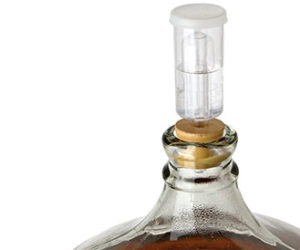Controlling Fermentation Temperature
Controlling the temperature of actively fermenting wort can have a major impact on the flavor of the finished beer. Fermenting above the normal temperature range may produce excessive fruity-flavored esters or harsh-flavored fusel alcohols. I once brewed a batch of ale during the summer and allowed the fermentation temperature to exceed 80 °F (27 °C). The finished beer tasted like a batch of Juicy Fruit gum!
Most homebrewers do not possess a sophisticated means to maintain fermentation temperatures in a suitable range. This is the reason that historically many beers that needed to be fermented in a cool environment (particularly lagers) were brewed during the winter months and stored in caves or cellars. This is also why I ferment ale in the winter and mead in the summer, when my basement is in the proper temperature range for each type of fermentation.
Normal ale fermentation temperatures range from 68 to 72 °F (20 to 22 °C) and lager fermentation temperatures from 45 to 55 °F (7 to 13 °C). Also keep in mind that the heat generated by an active fermentation can warm a typical 5-gallon (19-L) batch of beer by 10 to 15 degrees Fahrenheit (5.5 to 8.3 degrees Celsius). Even though a basement in a northern climate may be cool enough to keep ale fermentation from overheating, it is often not cool enough to properly conduct lager fermentation. On the other hand, fermenting below the normal temperature range for a given yeast strain may result in a sluggish or incomplete fermentation. So what if your brewing area does not hold a desirable fermentation temperature during the time you wish to brew? Following are a number of techniques to help manage fermentation temperatures that vary from the simple to the sophisticated.
Keeping it cool
A simple way to help cool your fermenting wort is by employing evaporation, the same way our bodies cool themselves on a warm day. Rather than allowing the wort itself to evaporate, place the fermenter in a large tub or pan of water and cover it with a t-shirt or other material that can wick the water out of the pan and let it evaporate from the outer surface of the fermenter, cooling it in the process. This method works best when the air surrounding the wet t-shirt is dry and/or circulated by a fan, allowing for increased evaporation of the water. Evaporative cooling using this technique can keep a fermenter approximately 5 to 15 degrees Fahrenheit (5.5 to 8.3 degrees Celsius) cooler than the surrounding air.
A somewhat more aggressive approach to keeping your fermentation cool is to add ice to the water surrounding the fermentation vessel. This technique requires a little more monitoring to be sure ice is replenished as it melts throughout active fermentation. This method also makes it difficult to control the temperature of the fermenting wort in an ice water bath, resulting in a situation where the wort might be kept cooler than desired. A little experimentation may be necessary to determine if evaporative cooling and/or ice water cooling provides the proper temperature range for your brewing environment. A self adhesive temperature strip placed on the outside of a fermenting vessel above the level of an ice water bath can provide a simple and convenient means of monitoring wort temperature during fermentation.
If the wet t-shirt and/or ice bath approaches prove insufficient to keep your fermentation in the proper temperature range, or won’t give you enough control, there are more advanced methods you can employ to get the job done. By setting up a recirculating pump in a separate container holding ice water (an insulated cooler works well) and pumping the chilled water to a bath surrounding your fermenter, you can achieve more control than with a simple ice water bath surrounding the fermenter. By adjusting the rate of flow or size of the water bath surrounding the fermenter you may be able to keep things cool without overdoing it.
To provide even more control to a recirculating cold water system, you can add a temperature controller with a temperature sensing probe. The temperature controller can be used to control the recirculating pump so it will pump cold water around the fermenter whenever the temperature of the fermenting wort rises above the desired temperature. Stopper thermowells are available to house a temperature sensing probe so it can be immersed in a carboy or fermenting bucket. A thermowell is simply a tube, often stainless steel, which is open on one end. The closed end of the thermowell is immersed in the liquid and the temperature-sensing probe is slid down inside the thermowell. This sort of control system can make your setup truly automatic except for keeping the ice water bath stocked with ice.
The same temperature controller can also be used to simply control the temperature inside a refrigerator or freezer. The temperature controller is plugged into a power outlet and then the refrigerator or freezer is plugged into the controller. The controller’s probe is then taped to the side of the fermenter or placed inside a stopper thermowell that is immersed in the wort. The thermostat can then be set to keep the refrigerator or freezer in a temperature range for the style of beer being fermented or the stage of conditioning (lagering) desired.
Temperature controllers come in both analog and digital models and have between a 1 and 4 degree Fahrenheit (0.5 to 2.2 degree Celsius) differential respectively, thus keeping the system they control in a 2 to 8 degree Fahrenheit (1.1 to 4.4 degree Celsius) temperature range. A temperature controller is necessary to keep the cooling system from running colder than the desired fermentation temperature. Temperature controllers are readily available to buy from homebrewing suppliers in the $50 to $100 price range. If employing a refrigerator or freezer for fermentation temperature control, it must be large enough to hold your fermenting vessel and be available for the job for the time required. Used refrigerators and freezers can often be acquired relatively inexpensively and only run when needed for fermenting or conditioning a batch of beer.
Keeping it warm
During certain times of the year a garage or basement brewery may not be warm enough for ale or mead fermentation. It then becomes necessary to invent ways to keep a fermentation warm without spending the energy (and money) keeping the whole house or brewing area at the proper temperature.
Perhaps the easiest method to warm a fermenter is to cover and wrap it with a blanket or other insulating material to retain the heat produced by the fermentation. A self-adhesive thermometer strip makes monitoring the temperature of the fermenting vessel simple.
If conserving the heat produced by the fermentation is not enough, there are also ways to add heat to the system. In the past, I have used an inexpensive submersible aquarium heater to warm water held in a large tub in which my carboy was placed. A self adhesive thermometer strip on my carboy allowed me to monitor the temperature as I adjusted the thermostat on the aquarium heater to achieve the desired temperature.
The flip side of using an insulated box (such as the Son of Fermentation Chiller mentioned earlier) to keep fermentation cool is to rig a light bulb inside the box to keep it warm and control the light by means of a temperature controller. Care must be taken to be sure the hot bulb will not contact any surface that could melt or catch fire.
For a few dollars more, there are products such as the Fermwrap, a flexible electric heating jacket that supplies heat over its entire surface area and is therefore safe to use on glass carboys or plastic buckets. The Fermwrap will typically raise the temperature of a five-gallon (19-L) batch an additional 10 degrees Fahrenheit (5 degrees Celsius). Additionally, the Fermwrap can also be coupled with a temperature controller and stopper thermowell to control the temperature with more precision.
Shoot the moon
If money is no object, you can go for the ultimate in temperature controlled fermentation with a glycol-jacketed conical fermenter with self-contained cooling and heating capability such as the model pictured on page 65 for $1,500 to $2,500 (I can dream, can’t I?). These units are thermostatically controlled to cool or heat the wort as needed to control the temperature in a narrow range. Some models are programmable to ferment, perform a diacetyl rest, then lager.
Whatever method you choose to control temperature during fermentation, it will be time and money well spent. The yeast that you use, and the environment it has to work in, has arguably the greatest impact on beer flavor of any part of the brewing process. There are many special and style-specific strains of yeast now available to the homebrewer. Each strain has a temperature range where it performs best. Managing fermentation temperature to get the most from a particular strain of yeast can move your brewing up to another level, or allow you to explore new styles of beer that you may not have been able to brew before.



